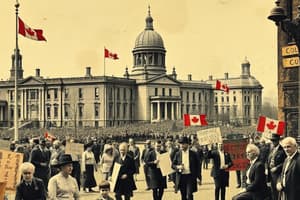Podcast
Questions and Answers
What is the scope of the Maps collection in terms of Canadian geography?
What is the scope of the Maps collection in terms of Canadian geography?
It covers all of the Canadian provinces and territories.
What is included in the Serials collection?
What is included in the Serials collection?
Dailies, weeklies, specialized journals, mass-market magazines, city directories, and annual reports from churches, schools, and corporations.
Over what period does the Monographs collection span?
Over what period does the Monographs collection span?
Three and a half centuries of Canadian documentary history.
What issue is addressed in the 'Statement on problematic content and descriptions in Canadiana'?
What issue is addressed in the 'Statement on problematic content and descriptions in Canadiana'?
What is the nature of the story told by the Canadiana Collections?
What is the nature of the story told by the Canadiana Collections?
What is the approach taken to the historical records in the Canadiana collections?
What is the approach taken to the historical records in the Canadiana collections?
How many Canadian maps are currently digitized in the Maps collection?
How many Canadian maps are currently digitized in the Maps collection?
What type of publications are included in the Serials collection?
What type of publications are included in the Serials collection?
What is the content of the Monographs collection primarily composed of?
What is the content of the Monographs collection primarily composed of?
Why did the Canadian government sign the treaties with Indigenous peoples?
Why did the Canadian government sign the treaties with Indigenous peoples?
What was the purpose of the Numbered Treaties in relation to Indigenous peoples?
What was the purpose of the Numbered Treaties in relation to Indigenous peoples?
Why did some Indigenous leaders sign the treaties, despite not being happy with the terms?
Why did some Indigenous leaders sign the treaties, despite not being happy with the terms?
What are some different interpretations of the treaties that have led to disputes between the Canadian government and Indigenous people?
What are some different interpretations of the treaties that have led to disputes between the Canadian government and Indigenous people?
Why did Plains Cree chief Mistahimaskwa (Big Bear) refuse to sign Treaty 6 in 1876?
Why did Plains Cree chief Mistahimaskwa (Big Bear) refuse to sign Treaty 6 in 1876?
Study Notes
Numbered Treaties
- The Numbered Treaties were a series of agreements between the Canadian government and Indigenous peoples, signed between 1871 and 1921.
- The treaties gave the government control of the land, while Indigenous peoples were promised goods, reserve lands, annual payments, and hunting and fishing rights.
Historical Context
- After Confederation, the Canadian government sought to expand westward, desiring the lands of the Hudson Bay Company (HBC), including Rupert's Land and the North-Western Territory.
- These lands were valuable for their natural resources and vast space, and could be used for European immigration and industrial and commercial developments.
- Canadian politicians feared the USA would take these lands if Canada did not, due to the concept of Manifest Destiny.
Background to the Treaties
- In 1870, the Canadian government obtained Rupert's Land and the North-Western Territory through an agreement with the HBC, which included addressing Indigenous claims to the lands.
- The government used the 1850 Robinson Treaties as a model for the new treaties, intending to negotiate with Indigenous peoples for the land.
Consequences of the Treaties
- The Numbered Treaties led to the government gaining control of the land, while Indigenous peoples received limited benefits in exchange.
Studying That Suits You
Use AI to generate personalized quizzes and flashcards to suit your learning preferences.
Description
Explore the historical context and details of the Numbered Treaties signed between the Canadian government and Indigenous peoples. The treaties were significant agreements that shaped the relationship between the government and Indigenous communities.




